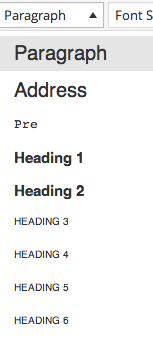Have you been using headings and heading tags in your blog posts? If not, it’s time to dust off your posts and help your readers.
Heading Tags Make Reading Easier

Headings also clarify for readers the main points. By having headings, your content is more memorable.
Heading Tags Help Search Engines Find You
While no longer as important as it was a few years ago, including Headings in your content helps search engines know with more detail what your content is about. See headings as one more chance to help your content be found.
Sometimes those headings and sub-headings can even appear as the blog post title in search results.
Heading Tags Best Practices
- Always use appropriate html code to mark headings, not just making fonts bigger or bolder. Search Engines don’t see style but will see html heading tags. In the code of your headings, you should see it like this:
<h2>My Awesome Heading</h2> - Save your H1 tags for page/post headings. This matters for search engines.
- H2 tags are great for breaking apart content within a post, much like an outline
- H3 tags are useful for sidebar widgets
- H4 and smaller make for useful headings in footers
- See a thorough rundown from Yoast: The heading structure for your blog
